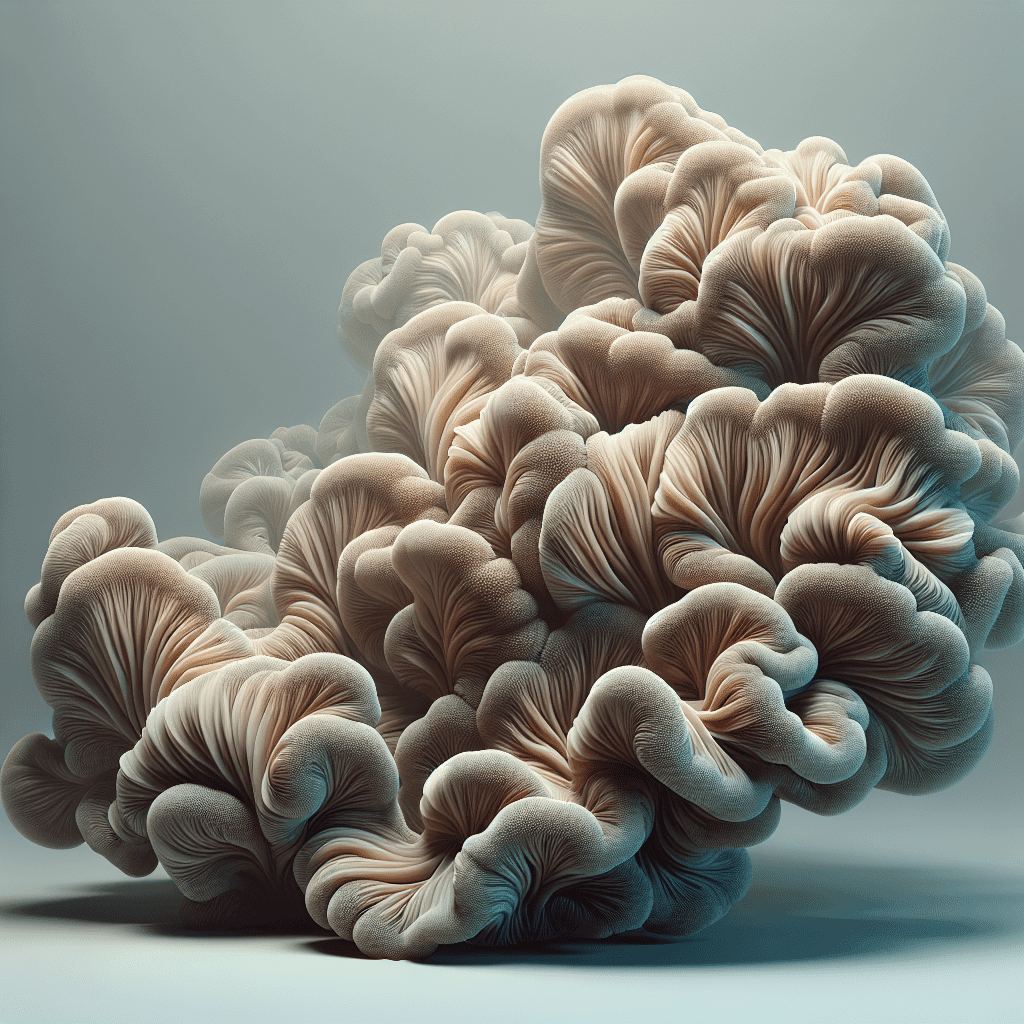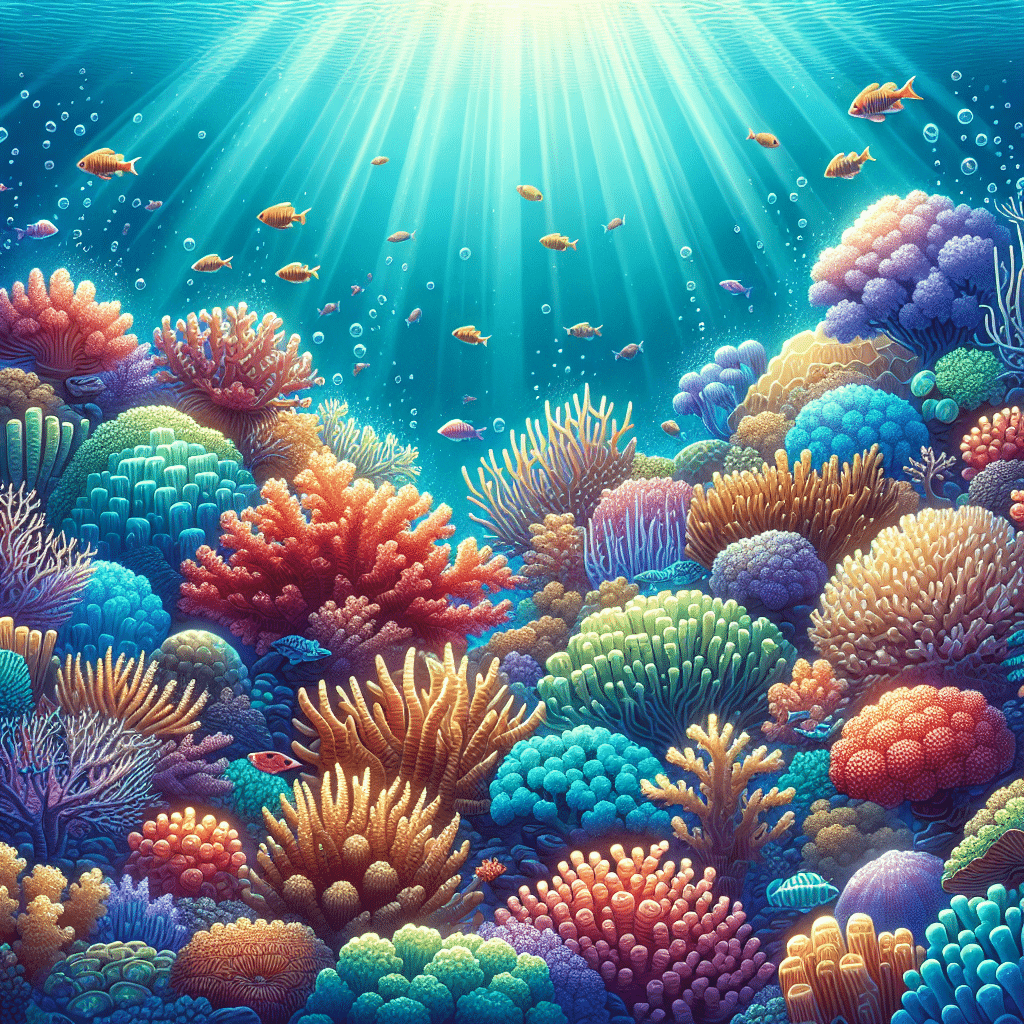Exploring Leather Corals
Introduction to Leather Corals
I find leather corals fascinating as they belong to the Alcyoniidae family, which includes a variety of soft corals that are popular in reef tanks. First documented by René Lesson in 1834, these corals have over 50 species within the Sarcophyton genus. They thrive in both temperate and tropical seas, often found in lagoons. Their unique adaptations make them suitable for aquarium life, and they can quickly grow from tiny to gigantic sizes, making them a striking addition to any reef tank.
Characteristics of Leather Corals
Leather corals have some distinctive features that make them appealing to hobbyists. They primarily exhibit colors like yellow, red, green, purple, brown, and orange. Their soft flesh is covered with small polyps, which can vary in appearance based on environmental factors. I love how they can even change color depending on the light intensity!
One of the most interesting aspects of leather corals is their ability to propagate by cuttings, which allows for easy expansion in a home aquarium. They prefer moderate water movement and can tolerate less-than-ideal water quality, making them quite resilient. However, it’s important to note that they can be aggressive, often engaging in allelopathy, which is a form of chemical warfare against other corals. To minimize this risk, I recommend keeping leather corals downwind from more sensitive species and utilizing activated carbon along with adequate filtration to maintain water quality.
Here’s a quick overview of some of the key characteristics of leather corals:
| Characteristic | Description |
|---|---|
| Family | Alcyoniidae |
| Growth Rate | Can grow quickly from small to large sizes |
| Color Variability | Yellow, red, green, purple, brown, orange |
| Propagation | Can be propagated by cuttings |
| Water Movement Preference | Moderate |
| Tolerance | Can tolerate hair algae and sub-optimal water quality |
| Aggressiveness | Can exhibit allelopathy |
For more information on different coral types, feel free to check out our sections on xenia, brain coral, and torch coral. Learning about these different species can help enhance your understanding of the reef tank ecosystem.
Types of Leather Corals
I’ve found a great variety of leather corals that can really enhance the beauty of any reef tank. Here’s a rundown of some popular types that I’ve come across.
Toadstool Leather Coral
Toadstool Leather Coral (Sarcophyton sp.) is a favorite among hobbyists due to its leathery texture and impressive tolerance to varying tank conditions. These corals can grow quite large and are long-lived. One specific variety is the Long Polyp Toadstool Leather Coral, known for its fast growth and long flowing polyps that can reach up to 2 inches in length.
Neon Green Spaghetti Finger Leather Coral
The Aussie Neon Green Spaghetti Finger Leather Coral is a stunning addition to any reef tank. Known for its vibrant colors, this coral has a care level classified as intermediate. It’s a show stopper that can draw attention due to its unique appearance and adaptability (Aquarium Creations Online).
Yellow Polyp Finger Leather Coral
This coral features thick, finger-like stalks growing from a wide, stocky base, giving it a fuzzy look. The Yellow Polyp Finger Leather Coral showcases beautiful yellow polyps, which can also appear in light green shades. It’s easy to care for, making it a great choice for both beginners and experienced hobbyists alike (Aquarium Creations Online).
Blue Devils Finger Leather Coral
The Blue Devils Finger Leather Coral is another excellent choice for beginners. It has a thick, cushiony body and adapts quickly to new environments. This coral is known for its ease of care and is likely to open up and show its polyps quickly after being added to a tank (Aquarium Creations Online).
Colt Coral
Colt Coral is popular for its beauty and hardiness. It has unique round to cone-shaped finger-like projections that branch upward from a short, pale white stalk. This coral is easy to care for, making it a great option for those new to the hobby (Aquarium Creations Online).
These leather coral varieties not only add color and texture to your reef tank, but they also provide a relatively easy care experience. If you’re looking to enhance your fish tank with corals, these options are definitely worth considering. For more information on other types of corals, check out our section on corals.
Care and Placement
Taking care of leather coral can be a rewarding experience, especially since they are relatively low-maintenance. Here’s how I ensure they thrive in my reef tank.
Tank Size and Spacing
Leather corals require a tank size of at least 75 gallons. This allows for proper growth and reduces competition for space with other corals. It’s essential to give them adequate spacing from other corals, as they can be aggressive and may exhibit toxic tendencies when stressed. Here’s a simple table to summarize these requirements:
| Requirement | Details |
|---|---|
| Minimum Tank Size | 75 gallons |
| Spacing | At least 3-6 inches from other corals |
Lighting and Water Flow
Leather corals thrive in low to moderate lighting conditions, with a recommended PAR (Photosynthetically Active Radiation) of 100-150. They have a symbiotic relationship with photosynthetic algae, which helps them obtain nutrients (Reef Chasers).
For water flow, moderate movement is ideal to keep them clean and help bring food to them. A moderate current can also assist in maintaining their overall health. Here’s a quick breakdown of lighting and flow:
| Requirement | Details |
|---|---|
| Lighting | Low to moderate (100-150 PAR) |
| Water Flow | Moderate |
Toxic Nature and Stress
One crucial aspect of caring for leather corals is their toxic nature. They are known to create allelopathy issues, which means they can produce chemicals that harm neighboring corals. Species like Sarcophyton and Lobophytum are particularly notorious for this. I make sure to keep them downwind from more sensitive species and use activated carbon for filtration to mitigate any chemical warfare effects.
It’s essential to monitor their health closely, as they can be sensitive to changes in their environment, especially to phosphate removing compounds containing aluminum oxide. If exposed to excessive amounts, they may remain closed for extended periods. Proper care and attention to their placement within the tank can help prevent stress and promote healthy growth.
By following these guidelines, I ensure that my leather corals not only survive but thrive in my reef tank environment. For more information on different types of corals, check out our articles on brain coral and mushroom coral.
Growth and Maintenance
Growth Rates of Leather Corals
Leather corals are generally slow growers. On average, most species grow about an inch every four months. However, in nutrient-rich environments with proper lighting and feeding, I’ve noticed that growth rates can increase significantly, reaching up to 1.5 inches per month. This growth potential is something to keep in mind when setting up your tank.
| Growth Rate | Description |
|---|---|
| 1 inch every 4 months | Typical growth in average conditions |
| Up to 1.5 inches per month | Accelerated growth in optimal conditions |
Leather corals can grow impressively in size, reaching up to 20 inches in length when properly cared for. In reef aquariums, larger specimens typically range from 4 to 7 inches. For those interested in smaller sizes, frags are commonly sold between 1-2 inches.
Propagation and Fragments
Propagating leather corals is quite straightforward. They can be propagated by cuttings, which involves taking a fragment of the coral and reattaching it to rock or substrate in the tank. It’s a great way to expand your collection or share with fellow hobbyists.
I recommend ensuring that the cut is clean and that the new fragment is placed in an area with moderate water movement. This helps them to establish themselves better. Keep in mind that leather corals can release a toxic film that may stress other corals in the tank. Maintaining good protein skimming and using activated carbon can help mitigate this. For more information on coral care, check out our article on corals.
Water Quality and Feeding
Water quality plays a crucial role in the health and growth of leather corals. They are sensitive to phosphate removing compounds that contain aluminum oxide, so it’s best to avoid those. Regular water changes and proper filtration can help maintain a healthy environment.
When it comes to feeding, leather corals can benefit from handfeeding with zooplankton, such as rotifers and newly hatched brine shrimp. This additional nutrition can accelerate their growth and enhance their overall health. Keeping an eye on water parameters and providing adequate nutrition can lead to vibrant and flourishing leather corals.
| Water Quality Essentials | Recommended Actions |
|---|---|
| Regular water changes | Maintain stable parameters |
| Avoid aluminum oxide | Prevent stress on corals |
| Handfeed zooplankton | Boost growth and health |
By focusing on these aspects of growth and maintenance, I’ve found that my leather corals thrive and contribute beautifully to my reef tank. For more coral varieties, consider exploring options like brain coral or mushroom coral.
Leather Coral Varieties
Leather corals are fascinating and versatile inhabitants for any reef tank. They belong to the Alcyoniidae family and come in various genera, with many species being beginner-friendly. Here, I’ll break down the primary varieties of leather corals that I find interesting and suitable for my tank.
Alcyoniidae Family
Leather corals are descendants of the Alcyoniidae family, which falls under the Suborder Alcyoniina. This family includes several genera that are popular among coral hobbyists. Notable genera include Alcyonium, Cladiella, Lobophytum, Sarcophyton, and Sinularia. These corals are known for their soft flesh and small polyps, making them visually appealing and relatively easy to care for.
| Feature | Description |
|---|---|
| Family | Alcyoniidae |
| Common Genera | Sarcophyton, Sinularia, Lobophytum, Cladiella |
| Growth Rate | Fast |
| Care Level | Beginner-friendly |
Sarcophyton Genus
The Sarcophyton genus is one of the most well-known in the leather coral family. First documented by René Lesson in 1834, there are over 50 species of Sarcophyton found globally in temperate and tropical seas, particularly in lagoons (Light Fish). These corals are beloved for their resilience and ability to thrive in various water conditions.
| Species Example | Colors Available | Common Size Range (inches) |
|---|---|---|
| Sarcophyton elegans | Yellow, Green, Brown | 4 – 12 |
| Sarcophyton glaucum | Red, Purple | 6 – 20 |
Sinularia, Lobophytum, and Cladiella
The genera Sinularia, Lobophytum, and Cladiella are also significant contributors to the leather coral category. Each of these genera has its unique characteristics and care requirements, but they all share the common trait of being soft corals that can be propagated easily through cuttings.
| Genus | Characteristics | Common Colors |
|---|---|---|
| Sinularia | Often has a branching structure | Yellow, Green, Brown |
| Lobophytum | Typically bushy, with a thicker base | Brown, Orange, Purple |
| Cladiella | Known for its finger-like extensions | Green, Brown |
Leather corals are truly versatile and can adapt to various conditions, making them a great addition to any reef tank. As I care for these corals, I appreciate their unique beauty and the ease with which they can thrive in my aquarium environment. If you’re interested in learning more about other coral types, feel free to check out articles on corals, xenia, and brain coral.
Disease and Toxicity
Leather corals are fascinating additions to any reef tank, but they come with some unique challenges. They can exhibit toxic tendencies and cause allelopathy issues that every hobbyist should be aware of.
Allelopathy Issues
Leather corals are known for their aggressive nature, which can lead to allelopathy, or what I like to call “chemical warfare.” This means that some leather coral species, like Sarcophyton, Lobophytum, Sinularia, and Lemnalia, produce toxins that can harm nearby corals. It’s essential to keep these corals downwind from more sensitive species to prevent stress and damage. Using activated carbon and ensuring good filtration can help mitigate these issues (Reef Chasers).
Toxic Tendencies
In addition to their allelopathic properties, leather corals can shed a toxic film. This film can come into contact with other corals, potentially causing stress or harm. To keep your tank healthy, I recommend maintaining good protein skimming and using activated carbon to minimize slime and toxins. If you’re considering adding leather corals to your reef tank, be mindful of these tendencies and plan your coral placement accordingly. They prefer moderate water movement, which can also help disperse any harmful substances they may release.
Maintenance and Filtration
Caring for leather corals requires attention to the tank’s overall maintenance and filtration. While leather corals are relatively hardy and beginner-friendly, it’s still important to ensure good water quality. They are not very susceptible to common coral diseases like STN (slow tissue necrosis) or RTN (rapid tissue necrosis). However, I advise against using phosphate-removing compounds that contain aluminum oxide, as leather corals can be sensitive to them. Handfeeding with zooplankton, like rotifers and newly hatched brine shrimp, can help accelerate their growth and keep them thriving (Saltcorner).
By keeping these considerations in mind, I can enjoy the beauty of leather corals while ensuring they coexist peacefully with other corals in my reef tank. For more information on different types of corals, check out our articles on brain coral and zoanthids.
Environmental Factors
Taking care of leather coral requires understanding various environmental factors that can affect their health and growth. Here’s what I’ve learned about lighting requirements, water temperature range, and the importance of trace elements.
Lighting Requirements
Leather corals thrive under low to moderate lighting. I’ve found that a light intensity of around 100-150 PAR (Photosynthetically Active Radiation) is ideal for their growth. Moderate water flow is also important as it helps bring food to the coral and keeps it clean. Leather corals filter-feed on nutrients in the water column and have a symbiotic relationship with photosynthetic algae, so getting the lighting right is crucial for their health (Reef Chasers).
| Lighting Type | Recommended PAR |
|---|---|
| Low to Moderate | 100-150 PAR |
Water Temperature Range
The natural temperature range for leather corals is generally around 82°F (28°C). They can adapt and survive in temperatures as low as 77°F and as high as 84°F. Keeping the water temperature stable within this range is essential for optimal health and growth. If you’re considering adding leather corals to your tank, make sure your water temperature is consistently maintained.
| Temperature Range | Ideal Temperature |
|---|---|
| Minimum | 77°F (25°C) |
| Ideal | 82°F (28°C) |
| Maximum | 84°F (29°C) |
Trace Elements Importance
Trace elements play a significant role in the growth and coloration of leather corals. Minor trace elements, such as Barium, Boron, and Iron, are essential for the biological processes of corals and other reef animals. The concentrations of these elements can vary greatly in seawater, which can impact coral health (Reef Builders).
Proper dosing of trace elements based on testing results is crucial to prevent overdosing. For example, an increase in copper concentration can be toxic to most invertebrates, including corals.
| Trace Element | Importance |
|---|---|
| Barium | Coral growth |
| Iron | Coloration |
| Copper | Toxic in high concentrations |
Understanding these environmental factors has helped me successfully care for my leather corals. By providing the right lighting, maintaining optimal water temperature, and ensuring proper trace element levels, I’ve seen my corals thrive. If you’re interested in learning more about different types of corals, check out our section on corals for more insights.
Coral Health and Coloration
Maintaining the health and vibrant coloration of leather coral is essential for any reef tank enthusiast. The right conditions can significantly impact how well these corals thrive.
Coral Growth and Coloration
I’ve noticed that healthy leather corals exhibit vibrant colors and robust growth. This is largely influenced by several factors, including water quality, lighting, and nutrient availability. When leather corals are well-cared for, they can showcase a range of colors, from rich greens to deep browns, depending on the specific species.
It’s important to monitor growth rates as well. Leather corals can grow at varying speeds, and understanding these rates helps in planning their placement and care in the tank. Some species may thrive faster than others, requiring different levels of attention.
Impact of Trace Elements
Trace elements play a vital role in the health and coloration of leather corals. Minor trace elements like Barium, Boron, and Zinc are critical for the biological processes of corals and other reef animals. These elements can often be limiting factors necessary for optimal coral growth and coloration.
The concentrations of trace elements in seawater can vary significantly, sometimes by up to 500% for certain elements. This variability can lead to debates among hobbyists about the ideal concentrations for coral husbandry (Reef Builders). Regular testing of trace elements is essential to ensure that they remain within safe and beneficial ranges.
Proper Dosing and Results
Proper dosing of trace elements is crucial. Overdosing can lead to toxicity; for instance, an increase in copper concentration can be detrimental to most invertebrates, including corals. By utilizing ICP testing, I can keep track of the concentrations of trace elements in my reef tank and make adjustments based on consumption and changes.
When administered correctly, the addition of trace elements has been shown to enhance coral growth and coloration. I’ve observed improvements in encrusting behavior, as well as more vibrant colors and healthier corals overall (Reef Builders). Keeping these factors in mind can lead to a thriving reef tank filled with healthy leather corals.



